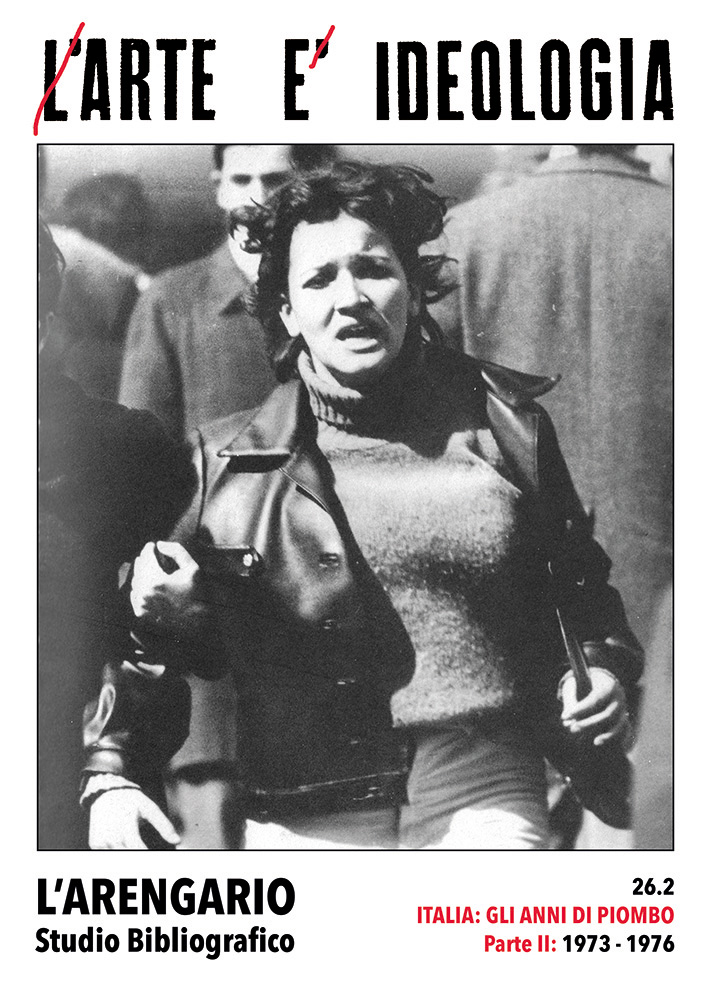L'ARENGARIO STUDIO BIBLIOGRAFICO - Dott. Paolo Tonini
Italia: gli anni di piombo. Libri riviste immagini documenti. Parte II (1973 - 1976)
Luogo: Cellatica
Editore: L'Arengario Studio Bibliografico, "Arte e ideologia 26.2"
Stampatore: prodotto in proprio
Anno: 2024 (8 febbraio)
Legatura: brossura
Dimensioni: 29,7x21 cm.
Pagine: pp. VIII - 144 (2)
Descrizione: copertina illustrata con una immagine fotografica in bianco e nero. Catalogo interamente illustrato a colori, 144 schede ragionate, a cura e con testo introduttivo di Paolo Tonini («Fazzoletti rossi: 1973 - 1976» / «Red handkerchiefs: 1973 - 1976»). Edizione digitale.
Bibliografia: N. D.
Prezzo: N. D.ORDINA / ORDER
"Si coprivano il volto con fazzoletti rossi gli operai che a Torino occupavano la Fiat Mirafiori nel marzo del 1973. Fu una iniziativa autonoma senza nessuna guida, né di un partito né dei sindacati, che proseguì nonostante il minaccioso comunicato dell’azienda [...] e si concluse con la firma del contratto nei primi giorni di aprile, il miglior contratto mai ottenuto dagli operai metalmeccanici. [...] Così nell’anniversario del 25 aprile furono i soldati - di leva e non - a coprirsi il volto con i fazzoletti rossi, e in giugno bandiere rosse sventolarono sui tetti del carcere di Rebibbia inaugurando la protesta dei detenuti in ogni penitenziario d’Italia. La protesta era ovunque; rivendicavano i propri diritti le donne, gli studenti, gli omosessuali, i disoccupati, cambiava la musica, cambiavano le feste: il movimento operaio diventava il punto di riferimento politico di ogni rivendicazione sociale. Era ovunque anche il piombo, come documenta la cronaca. Il 13 maggio 1974 il referendum per l’abrogazione della legge sul divorzio segna la sconfitta della Democrazia Cristiana e il 28 maggio scoppia una bomba in piazza della Loggia a Brescia, 8 morti e 102 feriti. In settembre la gente in rivolta occupa le case a San Basilio e Casalbruciato a Roma: viene ucciso Fabrizio Ceruso, 19 anni. Il 22 maggio 1975 viene promulgata la legge Reale: sarà vietato d’ora in avanti coprirsi il volto con un fazzoletto..." (dal testo introduttivo).
The workers who occupied the Fiat Mirafiori in Turin in March 1973, covered their faces with red handkerchiefs. It was an autonomous initiative without any guidance, neither from a party nor from the unions, which continued despite the threatening statement from the company [...], and ended with the signing of the contract on the first days of April, the best contract never obtained by metalworkers. [...] Thus on the anniversary of 25 April also the soldiers - conscripts and professional - covered their faces with red handkerchiefs, and in June red flags waved on the roofs of Rebibbia prison inaugurating the protest of prisoners in every penitentiary in Italy. Protest was everywhere; women, students, homosexuals, the unemployed claimed their rights, the music changed, the happenings changed: the workers' movement became the political point of reference for every social claim. Lead was also everywhere, as documented in the news of those years. On 13 May 1974 the referendum for the repeal of the law on divorce marked the defeat of the Christian Democrats party and on 28 May a bomb exploded in Piazza della Loggia in Brescia, killing 8 people and injuring 102. In September people in revolt occupied the houses in San Basilio and Casalbruciato in Rome: Fabrizio Ceruso, 19 years old, was killed. On 22 May 1975 the “Reale Law” was promulgated: from that moment it will be forbidden to cover the face with a handkerchief...
DOWNLOAD PDF FILE
The workers who occupied the Fiat Mirafiori in Turin in March 1973, covered their faces with red handkerchiefs. It was an autonomous initiative without any guidance, neither from a party nor from the unions, which continued despite the threatening statement from the company [...], and ended with the signing of the contract on the first days of April, the best contract never obtained by metalworkers. [...] Thus on the anniversary of 25 April also the soldiers - conscripts and professional - covered their faces with red handkerchiefs, and in June red flags waved on the roofs of Rebibbia prison inaugurating the protest of prisoners in every penitentiary in Italy. Protest was everywhere; women, students, homosexuals, the unemployed claimed their rights, the music changed, the happenings changed: the workers' movement became the political point of reference for every social claim. Lead was also everywhere, as documented in the news of those years. On 13 May 1974 the referendum for the repeal of the law on divorce marked the defeat of the Christian Democrats party and on 28 May a bomb exploded in Piazza della Loggia in Brescia, killing 8 people and injuring 102. In September people in revolt occupied the houses in San Basilio and Casalbruciato in Rome: Fabrizio Ceruso, 19 years old, was killed. On 22 May 1975 the “Reale Law” was promulgated: from that moment it will be forbidden to cover the face with a handkerchief...
DOWNLOAD PDF FILE

